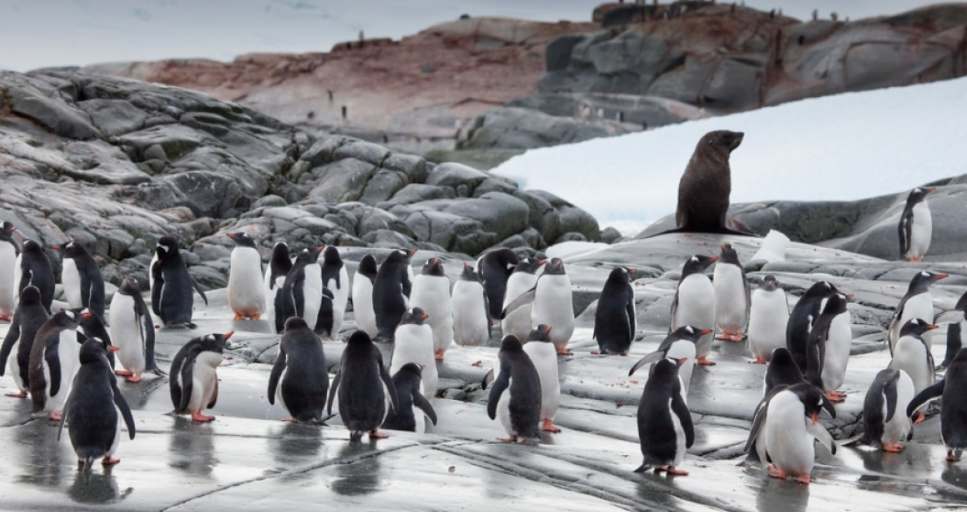The Waddling Gentoo Penguins
- Austin Chen

- Feb 18, 2021
- 3 min read
Introduction
With flamboyant red-orange beaks, white-feather caps, and peach-colored feet, gentoo penguins stand out against their drab, rock-strewn Antarctic habitat.
These charismatic waddlers, who populate the Antarctic Peninsula and numerous islands around the frozen continent, are the penguin world’s third largest members, reaching a height of 30 inches and a weight of 12 pounds. Gentoos are partial to ice-free areas, including coastal plains, sheltered valleys, and cliffs. They gather in colonies of breeding pairs that can number from a few dozen to many thousands.
Hunting & Feeding
Gentoo penguins have been known to make as many as 450 dives per day to forage for food. They can dive as deep as 200 metres (650 feet) and stay underwater up to 7 minutes. Although they prefer to stay close to shore, gentoos have been spotted as far as 26 km (16 miles) out to sea.
Adults spend the entire day hunting, usually close to shore, but occasionally ranging as far as 16 miles out. When pursuing prey, which includes fish, squid, and krill, they can remain below for up to seven minutes and dive as deep as 655 feet.

Mating Ritual?
Gentoo penguins choose shallow coastal areas for their breeding grounds, building nests among tufts of grass or rocky ground. Their colonies spread across many of the sub-Antarctic islands as well as the Antarctic Peninsula. Gentoos use stones to form a circle for their nests, and fights over those stones can become quite nasty. Stones are even a gift that male gentoo penguins sometimes give females when trying to woo them.
There is a large variety in egg-laying times depending on where a particular gentoo penguin is found. In warmer areas, this can occur as early as June, but in colder areas the laying period is delayed until December. Gentoo penguins are monogamous and have up to three breeding seasons, but generally they find new partners after that. Male gentoos attract females with gifts of stones and also by “trumpeting” skyward. If a female gentoo penguin chooses a male, both sexes point their bills at the nest the female has built.
After breeding, female gentoos lay two eggs that weigh about 130g each (4.6 ounces). Gentoo parents then switch incubation duties on a daily basis. The incubation period lasts about 35 days, and then the gentoo penguin chicks stay in the nest another 30 days before forming crèches. Gentoo chicks form these crèches, or nurseries, with other chicks for protection and warmth while they learn to fend for themselves. It takes about another month for the gentoo penguin chicks to grow their feathers, at which point they’re able to venture out to the sea

Possible Threats
Gentoo penguins are a favored menu item of the leopard seals, sea lions, and orcas that patrol the waters around their colonies. On land, adults have no natural predators other than humans, who harvest them for their oil and skin. Gentoo eggs and chicks, however, are vulnerable to birds of prey, like skuas and caracaras.
Gentoo numbers are increasing on the Antarctic Peninsula but have plummeted in some of their island enclaves, possibly due to local pollution or disrupted fisheries. They are protected by the Antarctic Treaty of 1959 and received near threatened status on the IUCN Red List in 2007.

Random Facts
Nobody is exactly sure why the word “gentoo” was applied to this particular penguin. The only other association with the word came from the 1630s, when it was an Anglo-Indian term used to distinguish Indian Hindus from Indian Muslims. This use of the word may have come from the Portuguese word gentio, which refers to gentiles.
The genus Pygoscelis means “rump-legged” and contains three brush-tailed penguins identified by their long tails, which sweep back and forth as they waddle.
Gentoo penguins are the third largest penguin species.
Unlike certain other penguin species, gentoos do not have a yearly migration cycle.
The weight and height of gentoos are found to increase the farther they live from the Antarctic Peninsula.
Gentoo penguins only breed in areas free of snow and ice.
Cleaniness is key. If the previous year’s nesting area is covered with waste or too trampled, gentoo penguins will locate the next year’s area somewhere else along the coastline.
Gentoo penguins are the only penguin species in the Antarctic Peninsula region that are expanding both in numbers and in distribution.
Sourced From/More Information:
Article 1 & Images:







Comments